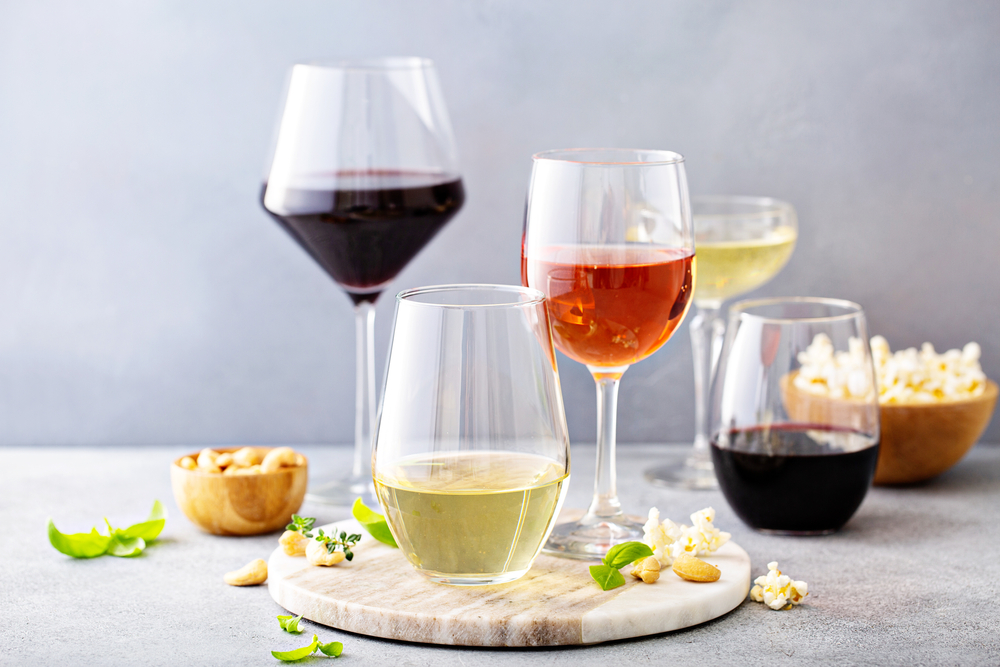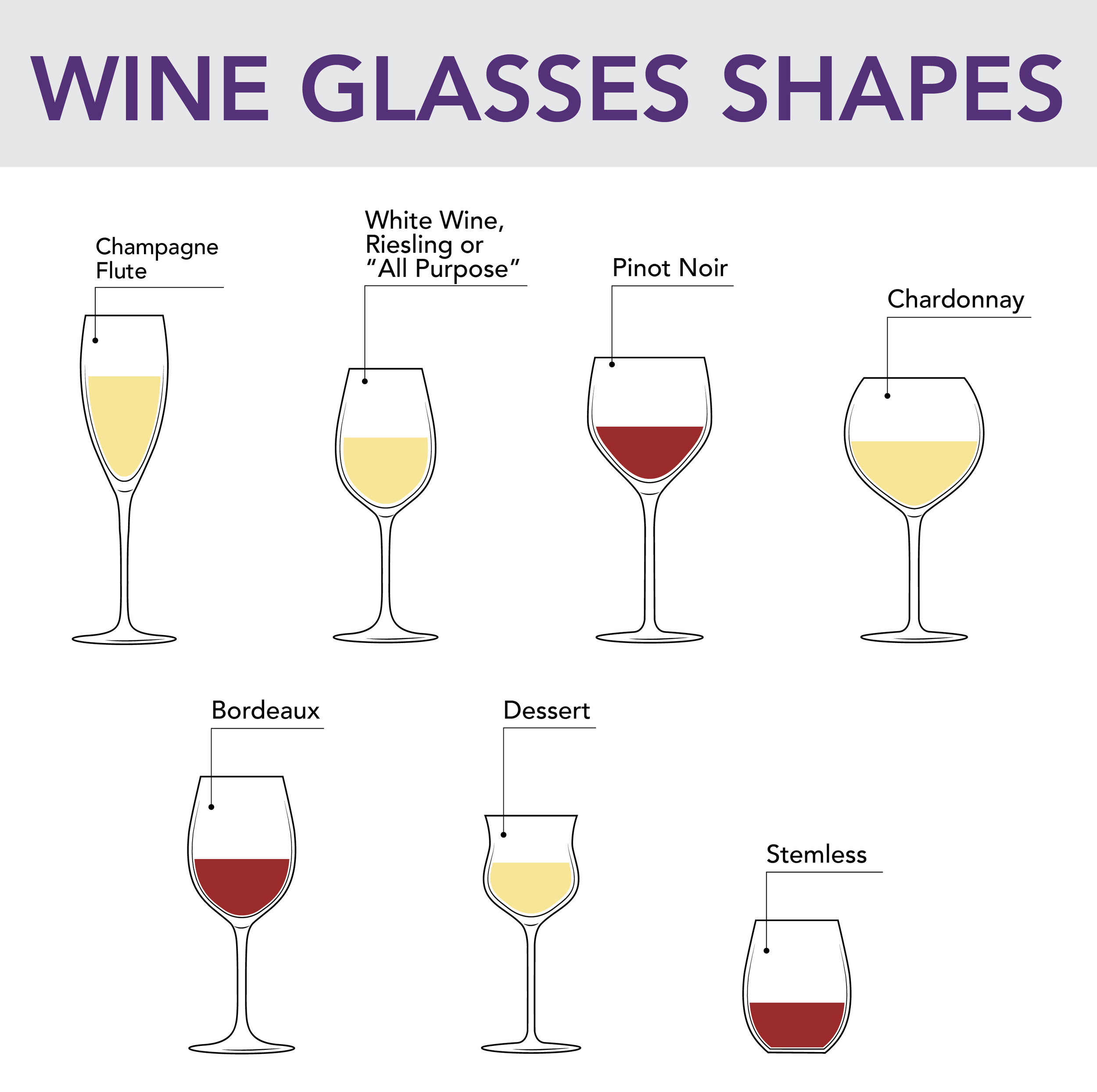I was a skeptic about the influence that glass shape has on the aroma of wine, until I attended a comparison tasting hosted by the glass company Riedel (pronounced “REED-uhl”) about seven years ago. They started out by pouring the same wine into a wine glass and a standard red plastic cup. We smelled the wine in the glass, and discussed its aromas before comparing with the cup. When I stuck my nose into the plastic cup, I couldn’t smell anything at all! Of course, aromas can still come from a plastic cup, but comparatively with the glass, the wine smelled neutral, like water. I was instantly convinced that glass shape is important.
That being said, the average wine drinker does not need to invest in dozens of different styles of wine glass. Glassmakers like Riedel use systematic tasting to determine the ideal size and shape for various styles of wine. Scientists have verified this connection between shape and aroma, as reported by Scientific American Magazine. Below are some descriptions of the main types of wine glass, as well as some suggestions about which of them you should invest in, or give as gifts to your wine loving friends and family. Remember – a glass only affects the flavor of wine if it is less than one third full.
Flutes
The slender, elegant shape of Champagne flutes are iconic. Reasons for serving sparkling wine in a flute include controlling portions and preserving effervescence. Most flutes are smaller than other glasses and can make your wine go farther. The shape of flutes minimizes the surface area of liquid in contact with air, which is meant to keep the sparkling wine from going flat. They are also quite attractive and have an refined, classic look.
Not everyone likes flutes, however. An Italian winemaker once told me that “Champagne flutes are an evil French conspiracy to ruin good wine.” The remark was at least partially tongue-in-cheek, as her husband is from France. It is true, however, that the shape of flutes tends to minimize the aromas and flavors of wine. Many professionals recommend drinking sparkling wine from a large, wide-mouthed glass, as it will heighten the aromatic character of the wine. Personally, I never use flutes, unless I’m serving an inexpensive sparkling wine to a large group as an aperitif.
Riesling or Light White Wine Glass (All-purpose)
If you only have one wine glass in your home, this is the one. It is smaller than many of the other styles, which is convenient for storage, cleaning, etc. This style is designed for lighter-style white wines, like Riesling and Sauvignon Blanc, but can work for wines of almost any style. Some glasses are sold as all-purpose and don’t advertise themselves as being for a particular style. Those glasses can be fine, so you don’t have to look for light white glasses in particular.
Pinot Noir or Red Burgundy Glass (second style to buy)
If you want to own two different styles of glass, use this one for red wine, and the previous type for white. As its name implies, this glass is designed for lighter-style red wines, like Pinot Noir and Gamay, but can be used for fuller reds as well.
Chardonnay or White Burgundy Glass
This glass is similar the Pinot Noir glass above. If you put them side by side, you’ll see that the Chardonnay glass is slightly shorter and wider. It is perfect for full-bodied whites like Chardonnay, and can also be used for sparkling wines like Champagne, as mentioned above.
Cabernet or Bordeaux Glass
The Cabernet glass looks like the Riesling glass, but is quite a bit larger. It is designed for full-bodied red wines, like Cabernet, Merlot, Malbec, and Amarone.
Grappa or Dessert Wine Glass
The Grappa or dessert sweet wine glass is named for a spirit made from leftover grape skins from the wine fermentation process. It’s a great style for rich, sweet wines like Sauternes or Port, as well as spirits like Grappa or Cognac. If you are drinking a lighter-style dessert wine like Moscato, I would recommend the Riesling glass instead.
Stemless
Stemless wine glasses have become popular in recent years. They are usually all-purpose in style and come in a variety of sizes. They are fashionable, easy to store and clean, and more stable than their long stemmed counterparts.
I personally prefer traditional glasses with stems for three reasons: First, holding a glass by the stem allows the true color of the wine to shine through without being affected by the color of your hand on the goblet. Second, holding a glass by the stem keeps your hand from warming up the wine. Third, holding wine by the stem prevents unsightly smudges on the surface of the glass.
Cleaning and Polishing
Some wine glasses are dishwasher safe and some are not. Usually, more expensive glasses are made from crystal and must be hand washed. Be careful not to hold the glass by the base and twist when washing. This motion is comfortable for most of us, based on how we wash water glasses etc., but it can cause the stem to snap off, which is extremely frustrating.
The two most important things to keep in mind with regard to washing wine glasses are the type of detergent or soap used, and the type of polishing cloth. The detergent should be as neutral as possible, so that it doesn’t leave a smell in the glass, and the cloth should be smooth, so it doesn’t scratch the glass. There are specially-made cloths available for polishing wine glasses, and some of them are worth it. The cloth itself should also be washed with neutral detergent, so it doesn’t have a soapy smell that can be left in the glass.





